...Featuring anomalous discoveries submitted to mcremo.com from around the world
| |
|
  Chert Artifacs |
Greetings, I have
collected and studied over 3000 Chert and quartz artifacts from the
same spot that strongly resemble Neanderthal technology. There are at
least 6 specific lithic parallels. It’s rather obvious. However, since it is
considered impossible by the archaeologists; I can’t get any response.
This Assembly has given up many secrets. It completely destroys the
Knapping paradigm; and connects many different Cultures, with both
lithic technology and Cultural Symbols. Basically, it shows that
advanced technology was used to make many if not most of our stone
artifacts. They could slice and cut Chert; and they could melt it. The
technology is very distinct and very consistent. I have the specimens.
I would like to share photos and information. I also would like to know
if there is any lithic specialist or archaeologist out there that is
brave enough to buck the paradigm. I can’t find any. Except you.
Thanks, and keep up the great work! Sincerely, Austus Mosley Michael Cremo responds: Being involved in alternative archeology can be a lonely experience, especially if you are trying to influence mainstream professional archeologists. The best way to do that is probably to get a degree in archeology and work within their profession. But short of that you at least can be aware of their research methods and standards of evidence. Actually, whether you are trying to interest mainstream or alternative archeologists, you have to know your audience. For the alternative archeology audience you might find it useful to attend a conference like the ones put on by the Ancient Artifact Preservation Society…or you could look at the newsletters of the Pleistocene Coalition. You can send me a few…pictures of your specimens, and I will tell you what I think, which may be positive or negative. |
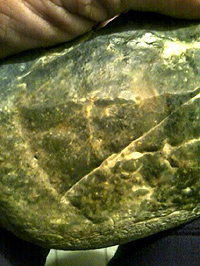 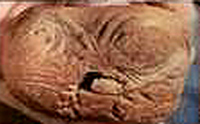 |
Alien Artifacts Hi, I recently
read about your interests in Forbidden artifacts. 8 years ago I
uncovered
thousands of artifacts on the beach. These artifacts are carved with
pictures
made out of quartz, chert, and other materials such as melted metals,
and
meteorites. I wrote a book about them myself because my museum was only
helping
me to a certain point in my state. I would really like to speak with
you on the
matter if you would not mind. I sent you a picture of the cover of my
book
showing what I have found. Please contact me and let me know if I can
speak
with you on this matter.
Michael Cremo responds:
You can write to me
giving a brief description pf your
finds.
|
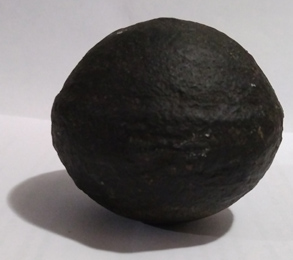 |
Grooved
Sphere
Hello, I have one of these spheres and I'm trying to sell it …If you have any suggestions please let me know. I will attach a picture.…My brother took it to [the] University of Louisville and spoke to a professor that taught archeology type classes he wanted to cut it in half, he said no. Professor told him it belonged in a museum…Would like to get it x-rayed. Just need advice on what to do with it. I didn't want it to be discarded if I passed. Would like to see if it is museum quality…I can send more pictures if you like or I could weigh it, it's pretty heavy. At first thought it was a Canon ball before I seen the show, but it's not magnetic. Lol Have a great day and thanks in advance for your time. Also this rock has gold or metallic surface not sure if you can see in the pics. I don't see where it could have been a bola rock. Michael Cremo responds: It looks like a sphere with an equatorial groove, somewhat corroded. It could be a bola stone. How did you get it, and where is it from? Thank you for the further details. That there is no information about where the object was originally found, makes it less meaningful from the scientific point of view. X-rays of the sphere sounds like a good idea. I can understand you not wanting to have it cut in half. You might considering giving a small sample of the object to some company that does metallurgic analysis. They could tell you what it’s made of… |
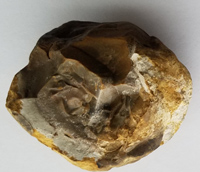 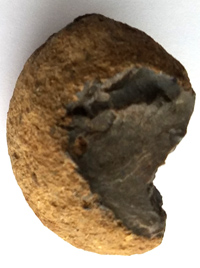 |
Pebble Choppers
Hi Michael
I am an amateur rock
explorer from Northern Alabama (Jackson
and Madison counties) I think I have found some amazing surface finds
on
private property that hopefully ties in with your book, Forbidden
Archaeology.
(Found in remote parts of a creek and river) I took several pictures,
front,
back and sides of two pebble choppers. Page 165 of your book. The last
is a
snake or turtle head? I also have many other artifacts (hand axes, an
amazing
stone cleaver with a carved hominid on the back. Please let me know how
to
proceed. I can send these items to you for inspection if you like.
Best regards, Michael Cremo responds: The objects do seem to be pebble choppers. For me the main consideration would be their age. I am interested in things that are too old to be accommodated in the current timeline of modern science. Most archeologists would say that no humans came to the Americas any earlier than about 30,000 years ago. So if these things are older than that, that would be significant. Of course, because they are surface finds, they would be hard to date. |
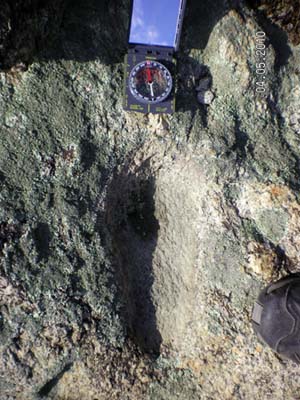 |
Footprint Found in Backyard
Michael, I have talked to you before concerning a "skull", but I need your input on this apparent "footprint" found in a stone. I will send a few pics for your review. Is it possible to tell the age of this apparent footprint from these pics? Michael Cremo responds: First thing you need to find out is the kind of rock. Footprints are preserved in sedimentary rock or layers of volcanic ash. If the rock is not in that category, the impression is most probably not a footprint. If it is sedimentary rock, and it is a footprint (and not just some natural mark that resembles a footprint), then a local geologist could tell you the age of the rock,and that would give you the age of the footprint. |
 Good evening. I came across this statue of a head and have no idea of what it is and was wondering if you could recommend someone that could help me in determining what it is. Here are some pictures of it. Thank you for any help that you can provide. -Rick RRJDK@aol.com |
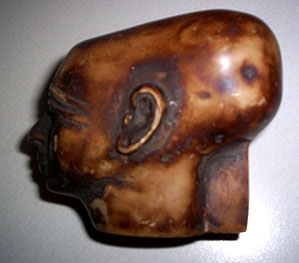 Michael Cremo responds: I would advise going to an art museum in a nearby city, one that has ancient art (Egyptian, Roman, Inca, etc. art), and see if one of the curators could give an opinion. The marking on the top of the head is not very clear, but it looks vaguely Egyptian to me. Best thing is to get in touch with a big art museum. Sometimes their websites allow you to ask questions to their experts. Or one can go personally or phone. |
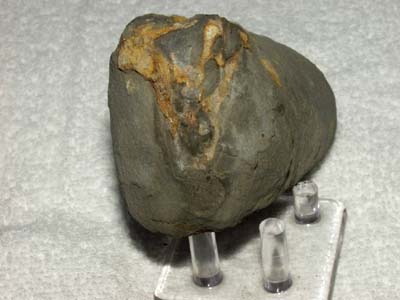
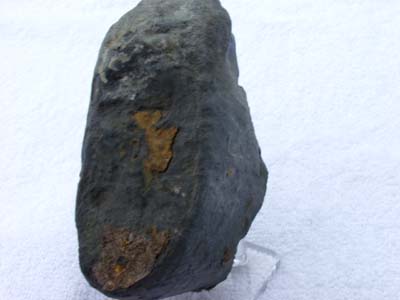 |
The Mazon Creek cast of child's
shoe 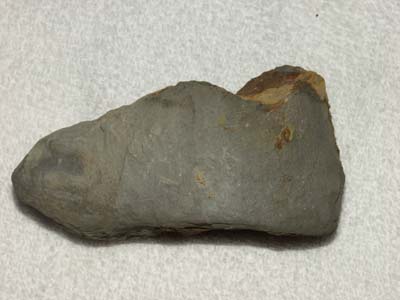 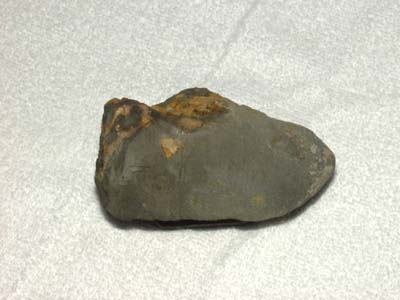 |
| Dear
Sir: I have found something I believe is significant. I live in the Mazon Creek area of Illinois where fossils are very abundant still. As an amateur fossil hunter, I was out last Saturday and found quite a surprise. As you know, the Mazon Creek fossils resulted from ferns and insects being covered with mud. The minerals in the mud eventually dissolved the plant insect material and a cast or impression was made in rock (ironstone). Well I found what I thought at first was just another concretion containing possibly a fern. But when I dusted it off, it appears I have found a cast of a child's shoe or slipper! There are details which are most convincing, such as a line showing an insole and detail on the heal of the shoe. It is just over 4 inches long. I think possibly that a shoe was covered over in a flood and filled with mud. The same principle applied where the minerals in the mud dissolved the materials of the shoe and we are left with a cast from the inside of the shoe. I wholeheartedly believe this is exactly what has happened and that this shoe is very old. I wish I could guess how old, however the matrix is the same as the Mazon Creek fossils. I would like to exhibit this find but only to professionals and serious researchers. I would appreciate if you could advise who to contact in this regard. Michael Cremo responds: For now, I think you are right that you have an interesting anomaly. It would be good, I think, if you could get some mineralogist or geologist to compare the filling of the object that you have with the casts of the admitted fossils and with admitted concretions. If the structure of the concretions and admitted fossils is different, and your object has a structure that resembles the admitted fossils, that would be interesting. I should say that in this field of anomalies there has to be some division of labor. I think that my major contribution has not been in conducting actual investigations myself (although occasionally I do it), but to give some publicity to interesting investigations carried out by others like yourself. I think we could put some of your pictures on our anomalies page, and see if we get any help from other people. Sincerely yours, Michael A. Cremo |
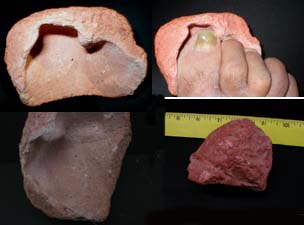 Rock with fossilized toeprints |
| Dear Michael: I found this stone in Truth or Consequences in an arroyo maybe less than 100 yards from the Rio Grande. I pick up rocks all the time and I was going to put this one in a friend's cactus garden. It slowly dawned on me that this was no ordinary rock. I frequently pick it up and place my thumb or toe in it and it has never failed to say I am human. I also took the rock to New Mexico State University. It was bad timing as most of the people were on spring break. I did find a geologist who took one look at the stone (Lufa) and said it was too old to possibly have a human print in it. I believe he was from the old school of thought and wouldn’t even consider the photos closely. I am not sure if they can be blown up on a computer screen for this purpose. When I look closely I can see the texture of skin. If there is someone specific I could send images to, I would appreciate the information. This area is rich in archeology. Several weeks ago I heard that another mastadon had been found near the Elephant Butte lake.About three years ago I was hiking nearby and found a complete palm frond in sandstone. What a thrill it will be if someone can confirm what my heart has been feeling, in regards to this little red stone. I hope the pictures are okay. Regards. Roy roylohr@zianet.com Dear Roy: Thanks for the pictures. Here are some Suggestions for further research on your possible human toeprint. If you have Forbidden Archeology, carefully study the reports on human footprints and toeprints in both the archeology and bigfoot sections of the book. It would be good if you could establish that the rock you have is of the kind in which footprints could have been made.In other words, in its original condition it should have been some kind of sand or clay or ash that could hold a print. Then you would want to look for anatomical features that would confirm it is not just some chance form, but a real print. One such feature might be fine ridgemarks in the rock, of the kind that might be made by a toeprint (the equivalent of a fingerprint, with its characteristic tiny ridgemarks). A geologist could look at the individual grains in the rock and see if they show any signs of pressure, as would happen when a foot presses into sand. The grains at the bottom might be pressed closer together than those toward the top. Also, you would want to find some way of judging the age of the rock.The geologist who refused to even consider that the rock could have prints is a good example of the knowledge filtering process in action.Also, I would think that the kind of investigation necessary is going to invoke looking at the objects themselves. Sincerely yours, Michael A. Cremo |
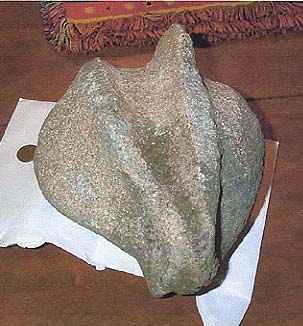 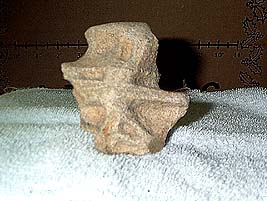 Grooved stone and mysteriously shaped figure in rock. |
| Dear
Mr. Cremo, My wife and I have listened to you many times on Art Bell's Coast to Coast. In your last appearance you mentioned something about grooved stones. A couple of years ago I found this object on our property which is next to Indian sacred land. I've tried to identify it but to no success. I was wondering if you could? On the bottom there is three grooved marks. [This other object] looks and feels like it's hand carved. To me it looks like a face, the bottom is as flat as can be. Michael Cremo responds: Thank you for sending the pictures of the artifact. I cannot identify what it is. It seems not to be any fossil organism. My first speculative thought is that it might be some piece of ritual paraphernalia, meant to channel some liquid in some ceremony. Sorry not to be of greater help in identifying it. |
Please send reports and pictures of your anomalous discoveries for possible
incluision in The Anomalies Pages and Forbidden Archeology Newsflash
online newsletter.
Send to:

The information presented here is not necessarily endorsed by Michael Cremo
All material is shared in the spirit of open and free inquiry.